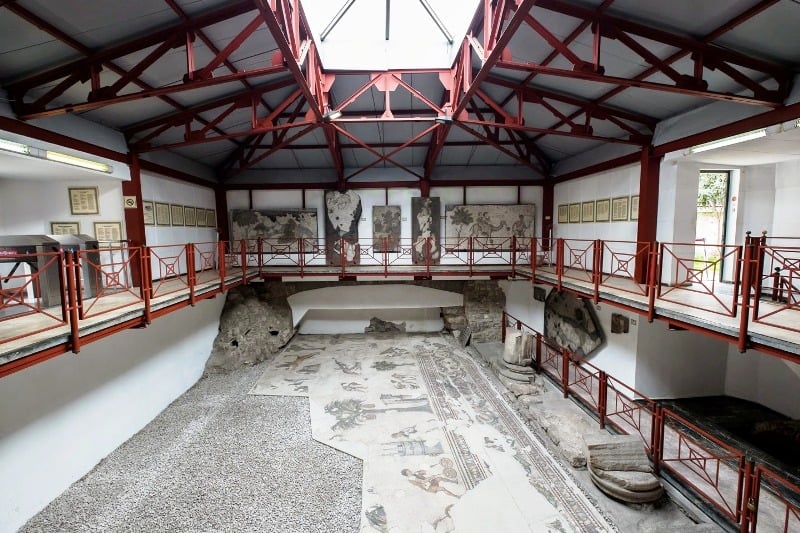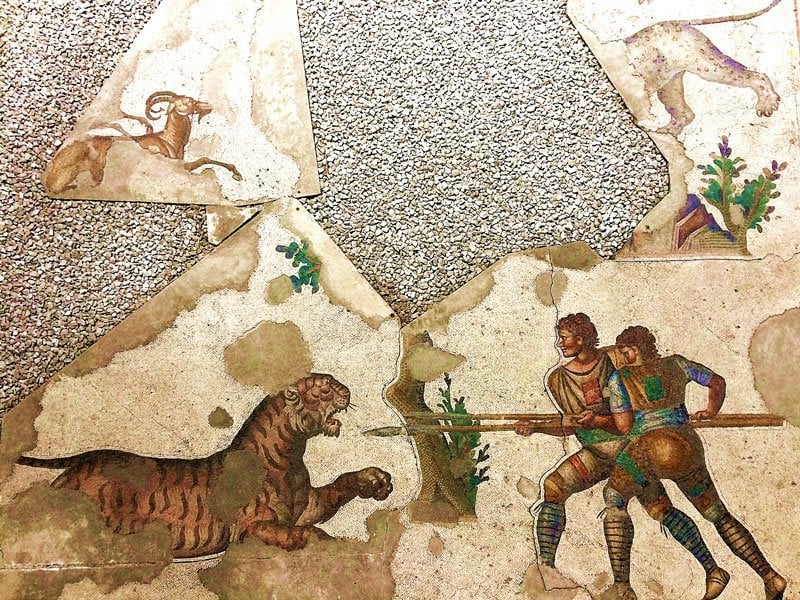The Great Palace Mosaics Museum, also known as Istanbul Mosaic Museum, is an impressive mosaics museum situated in the Arasta Bazaar within the Blue Mosque complex. The museum hosts one of the most beautiful mosaics in the world, that were preserved from the Great Palace of Constantinople, during the East Roman period from 610 until 641 A.C.. Especially the ones dated to AD 450-550.
General Info & History
During the East Roman period, artists who have come from the various regions of the country have made a huge mosaic with 40,000 pieces to the ground that covers 1,870 square meters. And afterwards, during the 7th and 8th century, when the painting was forbidden, the ground mosaics have been covered with huge marble panels and they were forgotten until they were revealed in 1921. And that also shows the reason that why those mosaics are in good condition today.

During the era of the Ottoman Empire, due the possible danger that may come from the sea, the Ottoman palaces were moved to Golden Horn region and a residential district were established over the area of the mosaics (having no idea that they were there), with the order of Fatih Sultan Mehmed, the conqueror of Istanbul.

And after a big fire on this Ottoman residential area, those hidden mosaics have showed up. Diggings and excavation works started in the year 1921 and and continued in between 1935-1951, and finally the mosaics and the remnants of the Byzantium palaces have been revealed. And so the site was declared as Great Palace Mosaics Museum in 1997.
What’s Inside
Step into the realm of everyday life, nature, and mythology through the mesmerizing mosaics unearthed in 1935 from the northeastern section of the cloister in the Eastern Roman Grand Palace. Dated between 450-550 AD, these artworks, displayed in the Great Palace Mosaics Museum, are not just magnificent artistically but also rich in depictions of scenes from daily life, nature, and mythology.
This unique collection, devoid of religious content, breathes with vitality and owes its brilliance to the expertise of numerous artisans under the guidance of leading masters of the era. Nestled within the Arasta Market in the Blue Mosque Complex, the museum was established to showcase the mosaic floor treatment preserved in the northeastern part of the colonnaded courtyard of the Great Palace.

You’ll see one of the most beautiful mosaics in the world. The mosaic stones at the museum consist of limestone, earthenware and colored stones, and the portrayals are placed in between the marble pieces.

Although only 180 square meters of the mosaic area have been uncovered, it holds a world of wonders. Originally under the management of the Istanbul Archaeology Museum in 1953, it later became a unit of the Hagia Sophia Museum in 1979.
The meticulous restoration and conservation efforts, initiated in 1982 through a protocol between the General Directorate of Monuments and Museums of the Ministry of Culture and the Austrian Academy of Sciences, were finally completed in 1997.
The mosaics, with grains of limestone, terracotta, and colored stones, boast an average size of 5mm. Employing the ‘Opus Vermiculite’ style and ‘Fishscale’ technique, the depictions are outlined with contours, creating a vivid and dynamic visual experience.
Among the extraordinary mosaics are scenes depicting a lizard eating a griffon, a fighting elephant and lion, a mare breastfeeding its colt, a goose shepherding children, a man milking a goat, a child feeding his donkey, a young girl carrying a jug, bears eating apples, and a dramatic depiction of a fighting hunter and tiger.
In total, the mosaics feature 150 human and animal figures across 90 diverse themes, weaving a captivating tapestry of ancient life and myth.
Visiting Tips
Why is Great Palace Mosaics Museum famous?
The Great Palace Mosaics Museum is renowned for housing one of the most impressive collections of Byzantine mosaics in Istanbul. These mosaics, dating back to the Byzantine era, showcase exceptional craftsmanship and offer a captivating glimpse into the art and culture of the time. Visitors are drawn to the museum for its historical significance, preserving and presenting these intricate mosaic masterpieces that once adorned the Great Palace of Constantinople.
Is Great Palace Mosaics Museum worth it?
The Great Palace Mosaics Museum is certainly worth a visit, especially for those interested in Byzantine history and art. The mosaics, depicting scenes from daily life, mythology, and religious motifs, are meticulously preserved and provide a unique perspective on the grandeur of the Byzantine Empire. The museum offers a serene and informative environment, making it a worthwhile stop for both history enthusiasts and casual visitors seeking a cultural experience in the heart of Istanbul.
Is there a dress code for Great Palace Mosaics Museum?
While there isn’t a strict dress code, it’s recommended to dress modestly as a sign of respect when visiting historical and cultural sites. This practice is generally in line with the cultural norms of the region and enhances the overall experience of engaging with the rich history and artistry of the Great Palace Mosaics.
How long do you spend at the Great Palace Mosaics Museum?
The duration of your visit to the Great Palace Mosaics Museum depends on your level of interest and the time you wish to dedicate to exploring the exhibits. On average, visitors often spend around 1 to 1.5 hours, allowing ample time to appreciate the details of the mosaics and absorb the historical context. However, those with a deeper interest in Byzantine art and history may choose to spend more time.
How to get tickets for Great Palace Mosaics Museum?
Tickets for the Great Palace Mosaics Museum can typically be purchased on-site or online. Online purchases may offer the convenience of skipping potential lines.
What time should I visit the Great Palace Mosaics Museum?
The museum’s opening hours can vary, so it’s crucial to check the official schedule before planning your visit. Early mornings or late afternoons during weekdays are often less crowded, providing a more relaxed atmosphere for exploration. Confirming the current operating hours will help you plan your visit accordingly.
Visiting Hours & Admissions
Opening Hours
Open every day between 09:30-19:30 (from 01 April to 31 October), 09:00-18:30 (from 31 October to 01 April).
Hours of Ticket Sale
Ticket counters close 30 minutes before the museum closing time.
Ticket Price
Please double check hours and admissions from muze.gen.tr
Where to Buy Tickets
You can buy them at ticket windows. There won’t be so much crowd. You can also find several guided museum tours in the city.
How to Get There
Location
You’ll find the Great Palace Mosaics Museum in the heart of the Sultanahmet Square (Hippodrome), in the Sultanahmet neighborhood of Fatih district. Situated just in Arasta Bazaar within the Blue Mosque compound, on the sea side. See the location map.
Transportation
The most practical way to get to Sultanahmet is via Bagcilar-Kabatas tram (T1 line).
- The closest tram stop is Sultanahmet.
- Sultanahmet Square and most of the connecting roads are closed for vehicle traffic except tram and tour buses.
- From Taksim, take the funicular to Kabatas (from taksim Square) or funicular to Karakoy (from Tunel square) and than take the tram.
- If you stay at the Sultanahmet hotels, than you easily walk to the museum.
Check our Sultanahmet page to see how to get to Sultanahmet in details.
Contact Details
Address: Arasta Çarşısı, Sultanahmet, Fatih, Istanbul
Tel: +90 212 518 12 05